Introduction: Plantar fasciitis is a common foot condition characterized by pain and inflammation of the plantar fascia, a thick band of tissue that runs across the bottom of the foot, connecting the heel bone to the toes. This condition often results in stabbing pain that usually occurs with the first steps in the morning. Finding the right shoes is crucial for managing the pain associated with plantar fasciitis.
Explain Its Relevance and Importance
Choosing the best shoes for plantar fasciitis can significantly improve one’s quality of life by reducing pain, preventing further injury, and promoting healing. This guide aims to provide detailed information on selecting the best shoes to alleviate the symptoms of plantar fasciitis.
Types and Categories
Different Classifications of Shoes
- Running Shoes: Designed to provide support and cushioning for high-impact activities.
- Walking Shoes: Built for comfort during prolonged periods of walking.
- Work Shoes: Suitable for various work environments, offering stability and support.
- Casual Shoes: Everyday footwear that combines style and comfort.
- Orthopedic Shoes: Specifically designed to support foot health and alleviate pain.
Specific Features to Look For
- Arch Support: Essential for distributing pressure evenly.
- Cushioning: Helps absorb shock and reduce impact on the plantar fascia.
- Heel Support: Stabilizes the heel and reduces strain on the plantar fascia.
- Flexibility: Allows for natural foot movement.
- Fit and Comfort: Ensures the shoe fits well without causing additional pressure points.
Symptoms and Signs
Common Symptoms
- Heel Pain: Most noticeable when taking the first steps in the morning.
- Stiffness: Particularly in the arch of the foot.
- Swelling: Around the heel area.
- Tenderness: When touching the bottom of the foot.
Uncommon Symptoms
- Numbness: Rare but can occur if nerves are affected.
- Burning Sensation: Indicates more severe inflammation or nerve involvement.
Causes and Risk Factors
Biological Factors
- Age: More common in individuals aged 40-60.
- Foot Structure: Flat feet, high arches, or abnormal walking patterns.
- Obesity: Extra weight puts additional strain on the plantar fascia.
Environmental Factors
- Inadequate Footwear: Lack of proper support can exacerbate symptoms.
- Occupational Hazards: Jobs requiring long periods of standing or walking on hard surfaces.
Lifestyle Factors
- Physical Activity: High-impact activities like running or aerobics.
- Sedentary Lifestyle: Lack of foot movement can lead to stiffness and pain.
Diagnosis and Tests
Common Diagnostic Tools
- Physical Examination: Assessing pain points and foot structure.
- Imaging Tests: X-rays or MRI to rule out other conditions.
- Ultrasound: Evaluates the condition of the plantar fascia.
Tests Used
- Windlass Test: Checks for tightness in the plantar fascia.
- Tarsal Tunnel Syndrome Test: Rules out nerve compression issues.
- Heel Compression Test: Determines the presence of heel pad syndrome.
Treatment Options
Medical Treatments
- Non-Steroidal Anti-Inflammatory Drugs (NSAIDs): Reduce pain and inflammation.
- Corticosteroid Injections: Provide temporary relief from severe pain.
- Physical Therapy: Strengthening and stretching exercises.
Therapies
- Extracorporeal Shock Wave Therapy (ESWT): Promotes healing through sound waves.
- Orthotic Devices: Custom insoles to support the foot structure.
- Night Splints: Keep the foot in a flexed position overnight.
Lifestyle Adjustments
- Weight Management: Reducing body weight to decrease stress on the feet.
- Activity Modification: Switching to low-impact exercises like swimming or cycling.
- Proper Footwear: Investing in shoes specifically designed for plantar fasciitis.
Preventive Measures
Tips and Strategies
- Regular Stretching: Stretching the calves and plantar fascia.
- Proper Footwear: Wearing shoes with good arch support and cushioning.
- Avoiding Hard Surfaces: Using cushioned mats or insoles when standing for long periods.
- Gradual Increase in Activity: Avoiding sudden increases in physical activity.
Personal Stories or Case Studies
Real-Life Implications
- John’s Journey: How changing his shoes helped him manage plantar fasciitis while training for a marathon.
- Mary’s Experience: Transitioning to supportive footwear reduced her need for pain medication.
- Tom’s Transformation: Using orthotic inserts and supportive shoes improved his daily comfort.
Expert Insights
Quotes and Advice from Medical Professionals
- Dr. Smith, Podiatrist: “Investing in quality shoes with proper support is the first step in managing plantar fasciitis.”
- Dr. Johnson, Orthopedic Surgeon: “Custom orthotics can make a significant difference in the long-term management of plantar fasciitis.”
- Dr. Lee, Physical Therapist: “Combining proper footwear with regular stretching exercises can alleviate symptoms.”
Conclusion
Summary of Key Points
Proper footwear is essential for managing plantar fasciitis. Look for shoes with good arch support, cushioning, and heel stability. Combine these with lifestyle changes and preventive measures to reduce symptoms and improve quality of life.

